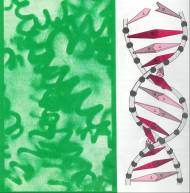|
|
|
|

|
Spirulina's shape is in the form of a spiral. All of the secrets of the universe are said to be contained in this form. The spiral is the symbol of infinity. DNA molecules form a double helix. Spirulina is considered as mother nature's molecular smart bomb.
|
|
|
4.) What are the various classifications of Blue-green microalgae such as Spirulina maxima, Spirulina platensis, Spirulina Pacifica, Anabeana, Aphanizomenon flos-aqua (AFA) or Super Blue Green?
|
|
|
There are approximately thirteen recorded varieties which belong to the genus "Anthrospira. These were described by the name "Spirulina." Spirulina maxima, and Spirulina platensis are two of the most known, researched and edible types of Anthrospira. Spirulina pacifica is a strain of platensis. In addition, there are approximately twenty-two species of the genus Spirulina or True Spirulina (Euspirulina), most of which do not propagate rapidly or may not be edible. There are also blue-green algae which resemble Spirulina and there are several varieties. These are called Pseudoanabaena which is the source of Anabeana, AFA (Super Blue Green Algae), Oscillatoria and others.
|
|
|
5.) What are some of the differences in blue-green algae ?
|
|
|
The most common aspects of all the variety of Blue-green micro algae is primarily their colors that range from grayish blue-green, blue green to brilliant blue-green as well as the sizes may differ in being a single cell or multi cellular organisms. Blue-green microalgae are also known as Vegetable Plankton, Phytoplankton, Monera or Cyanobacteria. Other differences are its spiral or helix form, filament, length, in addition to where they grow and the culture medium used to cultivate a particular type of algae as well as the methods of harvesting and drying.
|
|
|
6.) What is the difference in nutrient value between freeze dried and spray dried blue green algae?
|
|
|
Normally heat destroys enzymes in most foods. According to experts in the field of microbiology, the miracle of Spirulina is that it can come to life again, after being dried in heat as high as 160 degrees Fahrenheit (70 C). Some people think that Spirulina is less nutritious because it has been dried with air dryer heat or spray dried. This is not true for tropical Spirulina. It does not have to be freeze dried, as some assume in order to preserve its enzymes and nutrient value. In fact, just the opposite is the case. With Spirulina, any temperature below 70 degree F will stop it from growing, and at 60 degrees F the algae dies. There is no question of the natural enzymes surviving this amount of cold in tropical algae.
|
|
|
These assumptions and statements that the enzymes die in Spirulina with spray drying is based on competition rather than real experiments in the life cycles of this amazing plant. Enzymes can be preserved normally by refrigeration, but in the case of tropical raw Spirulina- blue-green algae, it is not preserved, and after a few days a bio-synthetic process occurs in the dark refrigerator to convert the high degree of chlorophylls into toxic compounds called pheophobides.
|
|
|
Therefore, tropical Spirulina should not be freeze dried but spray dried for less than a minute, immediately after harvesting, in order to dehydrate it into powder form to protect its' valuable nutrients. The enzymes and cells in Spirulina are still alive, because they normally grow in hot climates and lakes up to 170 degrees fahrenheit. (80 degrees Celsius) If they were not ground up and split up into tiny particle size, it would spring back to life again under the right conditions as has been done in research. These differences, do not make one type of algae better or worse than another. What does make the difference is the exposure to sun, elements in the air, nutrients in the water or culture medium. These differences may vary in even the same lake or pond depending on temperature, time, and turbulence changes. The only way to truly determine the difference in nutrient value between different species of algae is by testing the end product, with each batch produced.
|
|
|
7.) What is Spirulina maxima ?
|
|
|
Spirulina maxima is a class of nutritious blue-green algae, considered as the Sun Food of the ancient Aztecs, Mayans and Olmecs. Spirulina maxima is the official classification given the product by the Mexican government, in 1984, after an extensive five year study performed by the United Nations Industrial Development Organization (UNIDO), at the request of the Mexican FDA equivalent.
|
|
|
|
|